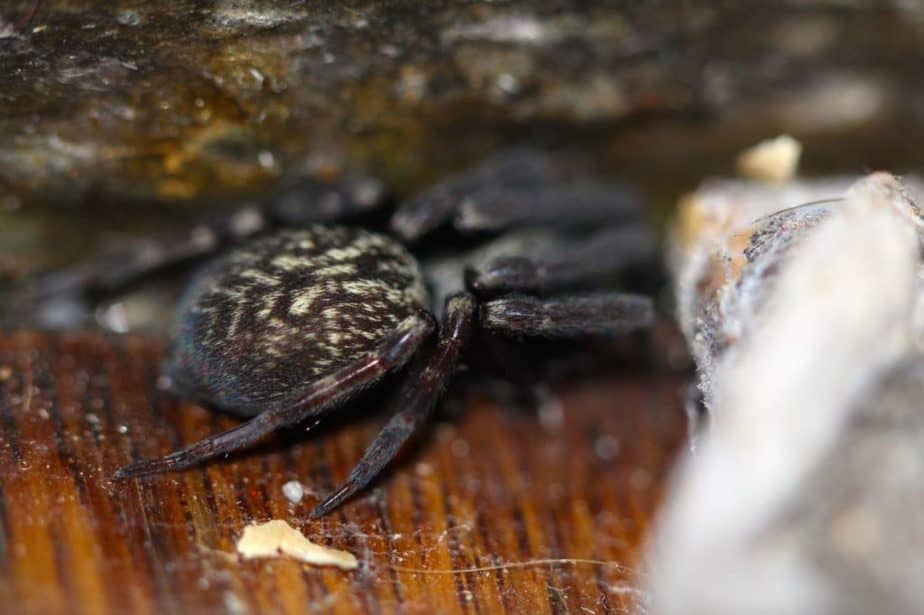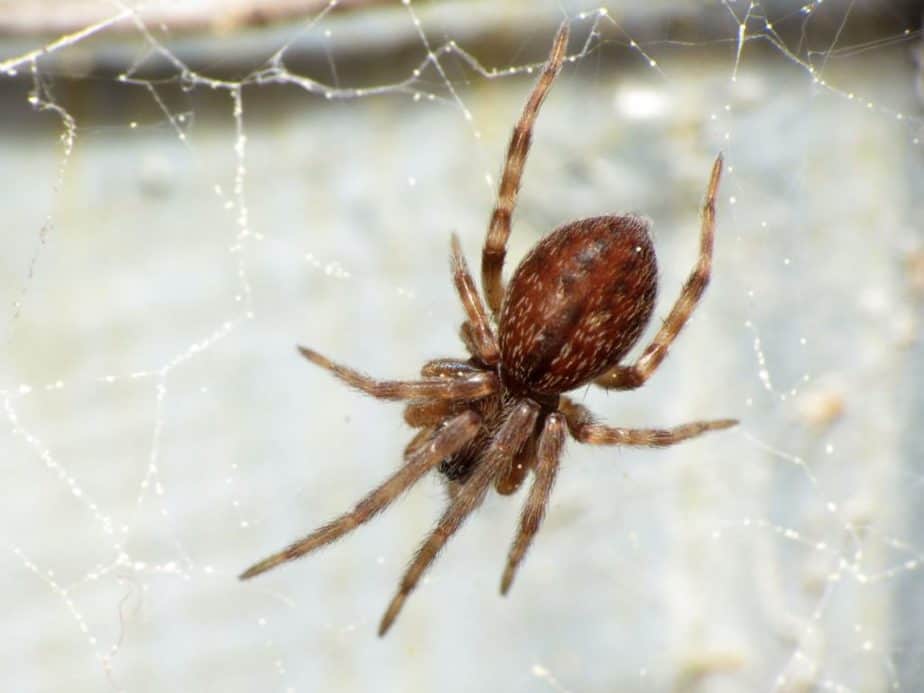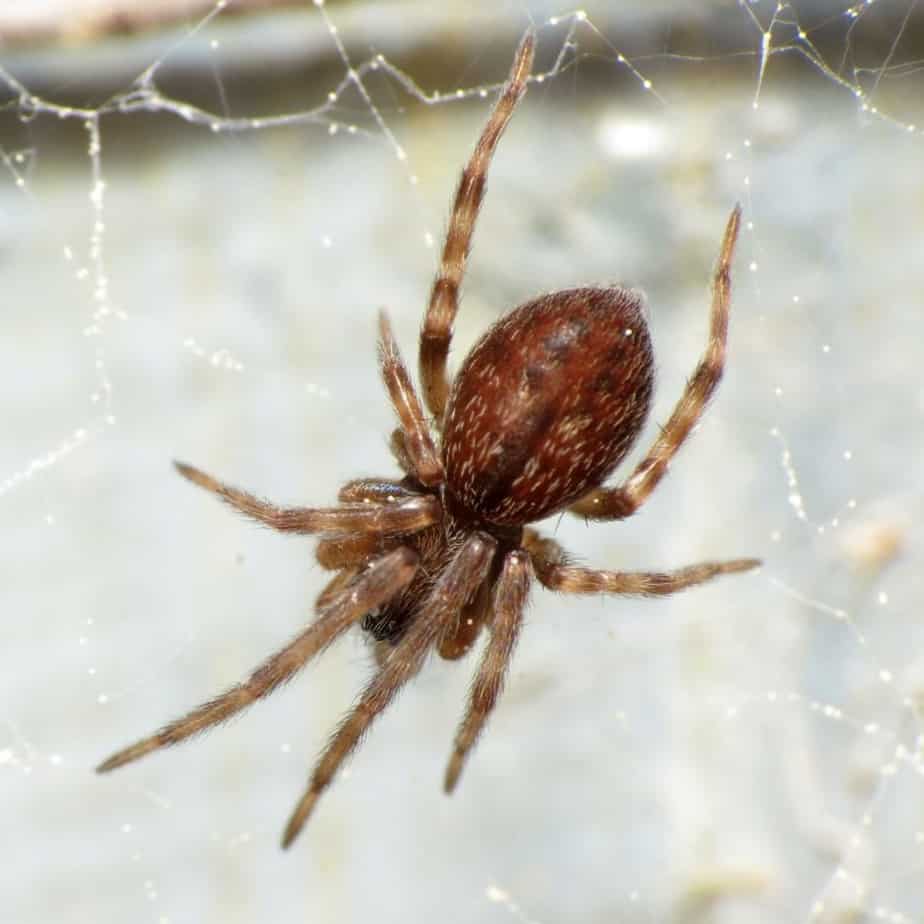The gray house spider, Badmuna longinqua, is a medium sized black and gray spider originally native to Australia. It has been introduced to New Zealand, South America, Europe, South Africa and the United States. Despite the reputation of Australian spiders, the grey house spider is harmless for humans and larger pets. Due to its secretive nature, it is rarely encountered by humans, even though their preferred habitat is inside people’s homes. In the United States, the largest populations of gray house spiders are found in California and Florida.
Gray House Spider Description
The gray house spider is a dark spider with relatively short legs. The cephalothorax (head) is almost black with some gray hairs while the oval-shaped abdomen is covered with gray hairs. The hairs on the abdomen look like gray spots on a black background with some lighter and some darker areas. The legs are black with black or dark gray bands.

Size
The gray house spider is a medium-sized spider. Adult females reach a maximum body length of 0.6 inches (15 mm). As is true for most spiders, males are smaller and reach a maximum size of 0.45 inches (12 mm).
Web
As their common name suggests, grey house spiders often build their webs inside human structures where they find moderate temperatures year-round. Females are believed to live for around two years and can spend their entire life on the same web – as opposed to many orb weavers who rebuild their large webs every single day.
Gray house spiders build disorderly and erratic webs around small cracks or other hiding places. The web contains a funnel that extends towards the hiding place surrounded by numerous strands of silk. These structures are called lace webs. The spider usually hides at the end of the funnel web during the day and emerges onto the web at night, waiting for small prey animals to pass by and getting stuck in the web.
Even though gray house spiders often live in houses, they are hardly ever seen due to their secretive nature.

Bite
Grey house spiders are timid spiders and usually remain well hidden throughout the day. Therefore, encounters with humans are rare and bites hardly ever occur. The spider’s first instinct is to escape rather than attack. In the rare cases in which a bite occurs, it is not known to cause harm to humans or larger pets.
Badumna longinqua scientific classification
- Kingdom: Animalia
- Phylum: Arthropoda
- Subphylum: Chelicerata
- Class: Arachnida
- Order: Araneae
- Infraorder: Araneomorphae
- Family: Desidae
- Genus: Badumna
- Species: Badumna longinqua
Occasionally, the gray house spider is also referred to as the brown house spider.
Geographic Range of the gray house spider in the United States
In the United States, the gray house spider can be found along the West Coast (Oregon, Washington, California) as well as in Florida and Hawaii.
References
- Taxon details: World Spider Catalogue
- Binominal name from: Koch, 1867
- Nentwig, W.; Blick, T.; Gloor, D.; Hangii, A.; Kropf, C. “Badumna longinqua”. Universitaet Bern. Universitaet Bern.
- Ubick, D. (2005). Spiders of North America: An Identification Manual. New York , USA: American Arachnological Society.


I have seen many of these spiders, they are quite large and seem to be all over my house. Sometimes they get in and I fear that the cats will try to eat them and get bit or get sick if they actually catch one. Their body is longer than 1/4″ and generally pretty close to 1/2″ when I find them, some larger than 1/2″ and generally shy.
Hi Gerry, could you please share your location to help with identification? Thanks!
Hi Gerry, assuming you are located in the Western U.S. or in Florida, this is most likely a gray house spider (Badumna longinqua): https://usaspiders.com/gray-house-spider-badumna-longinqua/
Location: Florida
Size: < 2mm
Can't identify this very small spider. I'm finding them in the house after the house was empty for a few months. They don't seem to flee from an old man with a magnifying glass but sometimes retreat quickly into the bathroom sink drain. .
Hello Don, thanks for getting in touch! This looks like a wall spider (Oecobius sp.): https://bugguide.net/node/view/15155
We just moved into a new house in Eastern Washington. I’ve seen this type of spider several times and am hoping to get more info about it and how to get rid of them! It’s between the size of a nickel and quarter (legs included).
Hello Maggie, thanks for getting in touch! This is most likely a gray house spider (Badumna longinqua). They are an introduced species from Australia, common in the Pacific Northwest. It’s not a medically significant spider: https://usaspiders.com/gray-house-spider-badumna-longinqua/
This one hitched a ride back in a storage container from Arroyo Seco Campground near Greenfield, CA.
I placed it outside and it looks like it’s still hanging around, so I was able to get a better photo.
It seems to have slightly hairy striped legs, a mostly grey and brown body, and it seems to have two front legs and two back legs that are longer than the others. When it’s hiding, it scrunches all of its legs up front to back.
Hello, this is a gray house spider (Badumna longinqua):
https://usaspiders.com/gray-house-spider-badumna-longinqua/
I woke up to this crawling sensation on my arm. Swiped my arm and instinctually knew it was a spider. Turned the light on and saw this dead on my bed. As a lifelong arachnophob, I did not return to bed and had to figure out a way to dispose for about an hour. It looked brown, dark color with an oval/long abdomen. Medium size. I’m located in Hawaii. Wondering which type of spider eek.